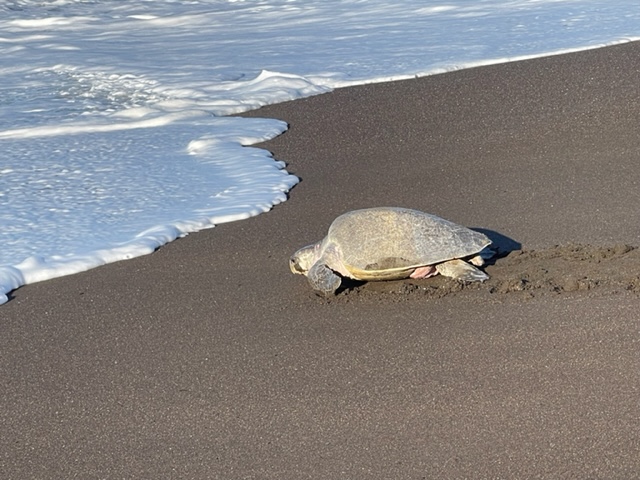As vultures circled menacingly overhead, I viewed the half-chewed carcass of a large turtle rotting in the hot, Costa Rican sun. Our tour guide pointed to the eggs still visible in the gaping body cavity, and hypothesized that a shark had bitten into the turtle before it had a chance to nest. At that point, I realized that the day’s outing to see the Olive Ridley turtles had taken an unexpectedly dark turn.
The trip to see an arribada at the Ostional National Wildlife Refuge was a passion project of my husband, who loves all animals. During an arribada, thousands of Olive Ridley sea turtles emerge from the ocean to lay their eggs at specific beaches around the world. Visitors to the Nicoya Peninsula in Costa Rica from July to November have a chance to see the event, which lasts only a few days per month.

Upon arriving at our hotel in Nosara, Costa Rica, after a 12-hour journey, the receptionist enthusiastically told us that we could see the arribada early the next morning. My husband eagerly set the alarm for 4:15 AM while reminding me that I did not have to go. Before daybreak, he sprang cheerfully out of bed, and again firmly stated that my participation was not required. I did not have a clear idea of what, exactly, the turtles would be doing or why we were going to see them. Yet, my fear of missing out overcame my instinct to burrow further under the covers.
The tour guide showed up 15 minutes late with a seven-seater car crammed with tired tourists. The driver made up for lost time by careening wildly through the streets at top speed. Luckily, the fact that the roads were unpaved and littered with oversized potholes did nothing to slow our progress. By the time we reached a swollen, fast river, I knew that the lack of a bridge would not prevent us from reaching the turtles and experiencing the magic of whatever the turtles were doing. My husband and I were wedged into the very back of the car with no chance of escaping if the current overtook us, so I decided to literally go with the flow as the driver entered the water and propelled us to the other side. He helpfully noted that the river had been so high the day before that he hadn’t even attempted the crossing.
We reached the wildlife refuge mostly unscathed. With no sense of foreboding, my sweet husband innocently observed, “Hey, that’s a vulture. I wonder what he’s doing here?” We walked on a path that opened up to a large beach littered with broken turtle eggs and reeking of rotting wildlife. Admonishing us to watch where we stepped, our guide led us down the sand until we saw something move at our feet. A stream of tiny, baby turtles emerged from a hole in the ground and made a beeline for the ocean. Everywhere we looked, turtle babies were swarming towards the water.

The initial reaction of awe and adoration for the little fellas was quickly overtaken by the horror of the natural drama playing out in front of us. The new turtles had to move fast, or they would be eaten by predators on land. Reaching the ocean was no guarantee of survival, as hungry seabirds and fish awaited them. An anxious person, I felt protective over the newborns, but there was nothing we could do to assist or save them. Our guide told us that the babies would never live if they couldn’t navigate themselves to the ocean. We learned that they were in a grim race against nature and man-made threats, such as climate change and suffocation from marine debris. The fact that the turtles hatched at all was a minor miracle. Turtle eggs are valuable, and poachers earn money stealing and selling them to restaurants.

Most people experiencing the arribada will see either the mama turtles nesting OR the babies hatching. We had arrived during a small window of time where we witnessed both events. As the babies ran towards the ocean, large mama turtles sat on the beach depositing their eggs and covering them with sand. The mothers must swim long distances to reach the beaches. The effort exhausts them, and many never make it back to the ocean. Trained volunteers gently tried to help many of the struggling mothers, but some are simply too tired and die where they lay. Others bravely manage to swim into the ocean, only to be swept back to the beach by the vicious tides. As we walked along the beach trying not to step on the babies, we saw some mothers successfully launch themselves into the water. We also saw rotting carcasses, and still others being eaten by the vultures. There were many, many vultures.

Watching the arribada was a privilege, especially as the population of sea turtles around the world is plummeting. This particular privilege, however, doesn’t sugar-coat the brutalities of nature for the benefit of tourists. We saw the raw power of life, survival, and death up close–a reality that many modern-day humans try to ignore. The mama turtle half-eaten by the shark will probably haunt me forever, and I will never be able to hear the song “The Circle of Life” from the Lion King in quite the same way again. Yet, if I had it to do over, I still would wake up in the middle of the night and climb into that death-trap of a car to reach the turtles.
As we arrived back at the hotel, the receptionist eagerly asked, “How was it? You were so lucky to see the arribada.” I looked at her expectant, happy face and truthfully replied, “Oh, yes, I have never seen anything like it.”
Categories: Costa Rica, Travel
